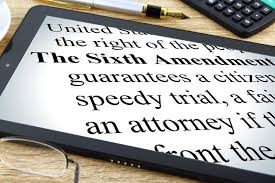Sherman, Texas Probation Revocation Attorney: The Right to a Speedy Hearing (Part 1)
 A Defendant formally accused of violating probation also has the right to a speedy revocation hearing. In addition to statutory provisions addressing timeliness in motions to revoke, the Court of Criminal Appeals has historically recognized two sources of law which provide for the right to a speedy revocation hearing: (1) the statutory and former common law doctrine of due diligence, and (2) Constitutional speedy hearing rights under Barker v. Wingo. 407 U.S. 514 (1971). of due diligence has been superseded by statute in Article 42A.751(d).
A Defendant formally accused of violating probation also has the right to a speedy revocation hearing. In addition to statutory provisions addressing timeliness in motions to revoke, the Court of Criminal Appeals has historically recognized two sources of law which provide for the right to a speedy revocation hearing: (1) the statutory and former common law doctrine of due diligence, and (2) Constitutional speedy hearing rights under Barker v. Wingo. 407 U.S. 514 (1971). of due diligence has been superseded by statute in Article 42A.751(d).
In 2015, the Texas Legislature added the statutory due diligence defense to the Code of Criminal Procedure, which overrode the common law defense. It states: For the purposes of a hearing under Article 42A.751(d), it is an affirmative defense to revocation for an alleged violation based on a failure to report to a supervision officer as directed or to remain within a specified place that no supervision officer, peace officer, or other officer with the power of arrest under a warrant issued by a judge for that alleged violation contacted or attempted to contact the defendant in person at the defendant’s last known residence address or last known employment address, as reflected in the files of the department serving the county in which the order of community supervision was entered.
When a motion to revoke is filed, the judge normally issues a warrant for the probationer’s arrest, though they may issue a summons. After fifty years of recognition by the Court of Criminal Appeals, the common law doctrine of due diligence in executing a warrant in motions to revoke has been eliminated. Compare Peacock v. State, 77 S.W.3d 285, 288-89 (Tex. Crim. App. 2002) (finding it imprudent to overturn 40 years of precedent requiring due diligence by State in executing motion to revoke capias) with Garcia v. State, 387 S.W.3d 20, 22 (Tex. Crim. App. 2012) (“we conclude that the 2003 statutory amendments to the Texas Code of Criminal Procedure Article 42.12 replaced the common-law due-diligence scheme).
 Sherman & Plano, TX Criminal Defense Lawyer Blog
Sherman & Plano, TX Criminal Defense Lawyer Blog


 The reasons for the delay of a trial are important under the second prong, and the State will be required to put forward their reasons at a dismissal hearing. Right now, blood and drug results from the State laboratory are taking six months or so to process. A person sitting in jail on a misdemeanor is heavily prejudiced by waiting that long on a chemical result. A person awaiting felony trial is not as prejudiced per the caselaw, but after nine months or so prejudice can sometimes be shown. A lawyer should consider filing a speedy trial motion in any trial that will be lengthily delayed by chemical testing, DNA testing or other factors under the State’s control.
The reasons for the delay of a trial are important under the second prong, and the State will be required to put forward their reasons at a dismissal hearing. Right now, blood and drug results from the State laboratory are taking six months or so to process. A person sitting in jail on a misdemeanor is heavily prejudiced by waiting that long on a chemical result. A person awaiting felony trial is not as prejudiced per the caselaw, but after nine months or so prejudice can sometimes be shown. A lawyer should consider filing a speedy trial motion in any trial that will be lengthily delayed by chemical testing, DNA testing or other factors under the State’s control. The Texas Court of Criminal Appeals analyzes both speedy trial and speedy revocation motion matters under the factors set forth by the United States Supreme Court in Barker v. Wingo, 407 U.S. 514 (1972). These factors include: (1) the length of the delay, (2) the reasons for the delay, (3) the defendant’s assertion of the right (to a speedy trial), and (4) the possible prejudice to the Defendant as a result of the delay. As applied to this case, the State cannot overcome the presumptive prejudice associated with a thirty eight month delay in executing the capias, a similar delay in hearing from the time of issuance, and at least three of four Barker factors weigh in favor of dismissal.
The Texas Court of Criminal Appeals analyzes both speedy trial and speedy revocation motion matters under the factors set forth by the United States Supreme Court in Barker v. Wingo, 407 U.S. 514 (1972). These factors include: (1) the length of the delay, (2) the reasons for the delay, (3) the defendant’s assertion of the right (to a speedy trial), and (4) the possible prejudice to the Defendant as a result of the delay. As applied to this case, the State cannot overcome the presumptive prejudice associated with a thirty eight month delay in executing the capias, a similar delay in hearing from the time of issuance, and at least three of four Barker factors weigh in favor of dismissal. Going back to the Constitution of the United States, American citizens are guaranteed a speedy and public trial. The public part is why a Court cannot bar you from entering to watch a trial unless you are a witness, but the speedy part has been developed over the years. I will concentrate on the State of Texas right to a Speedy Trial this week, which is overwhelmingly similar to the Federal Right but without a few federal specific statutes that can effect federal criminal cases. Additionally, citizens also have a right to a speedy hearing if the State of Texas files a motion to adjudicate or revoke probation, which is the procedure upon an alleged probation violation to impose sentence or modification.
Going back to the Constitution of the United States, American citizens are guaranteed a speedy and public trial. The public part is why a Court cannot bar you from entering to watch a trial unless you are a witness, but the speedy part has been developed over the years. I will concentrate on the State of Texas right to a Speedy Trial this week, which is overwhelmingly similar to the Federal Right but without a few federal specific statutes that can effect federal criminal cases. Additionally, citizens also have a right to a speedy hearing if the State of Texas files a motion to adjudicate or revoke probation, which is the procedure upon an alleged probation violation to impose sentence or modification.


 The Sherman and Plano Federal Courts are full of extradition cases from Latin America regarding drug smuggling. These individuals have often never set foot into the United States, so how can they be prosecuted here. Like the previous blog on airplane jurisdiction, the United States Congress has passed laws to make their global land jurisdiction as broad as possible. U.S.C. 959(c) states:
The Sherman and Plano Federal Courts are full of extradition cases from Latin America regarding drug smuggling. These individuals have often never set foot into the United States, so how can they be prosecuted here. Like the previous blog on airplane jurisdiction, the United States Congress has passed laws to make their global land jurisdiction as broad as possible. U.S.C. 959(c) states: In Morrison v. National Australia Bank, 561 U.S. 247 (2010), the Supreme Court applied the presumption against extraterritoriality to securities fraud statutes. Again in Kiobel v. Royal Dutch Petroleum, 133 S.Ct. 1659 (2013), the Supreme Court applied the presumption and held the plaintiff lacked extraterritorial jurisdiction under the Alien Tort Statute. In 2016, however, in RJR Nabisco, Inc. v. European Community, 136 S.Ct. 2090 (2016), the Court held the Racketeer Influenced and Corrupt Organizations Act (RICO) could apply extraterritorially. But the Court severely limited the application of RICO to foreign conduct that violates “a predicate statute that manifests an unmistakable congressional intent to apply extraterritorially.” Still, the Court held RICO’s private right of action does not overcome the presumption. Thus, the Supreme Court has revived the presumption against extraterritoriality and reinforced a high burden to overtake the canon to apply a law extraterritorially.
In Morrison v. National Australia Bank, 561 U.S. 247 (2010), the Supreme Court applied the presumption against extraterritoriality to securities fraud statutes. Again in Kiobel v. Royal Dutch Petroleum, 133 S.Ct. 1659 (2013), the Supreme Court applied the presumption and held the plaintiff lacked extraterritorial jurisdiction under the Alien Tort Statute. In 2016, however, in RJR Nabisco, Inc. v. European Community, 136 S.Ct. 2090 (2016), the Court held the Racketeer Influenced and Corrupt Organizations Act (RICO) could apply extraterritorially. But the Court severely limited the application of RICO to foreign conduct that violates “a predicate statute that manifests an unmistakable congressional intent to apply extraterritorially.” Still, the Court held RICO’s private right of action does not overcome the presumption. Thus, the Supreme Court has revived the presumption against extraterritoriality and reinforced a high burden to overtake the canon to apply a law extraterritorially.